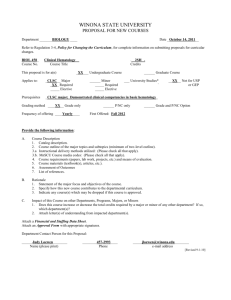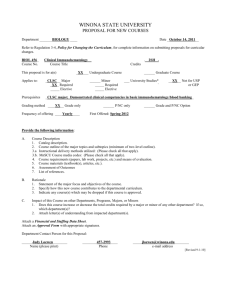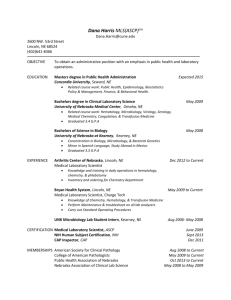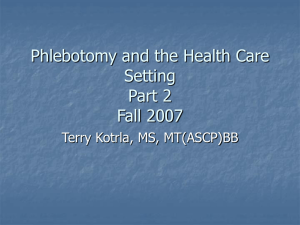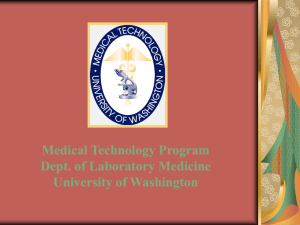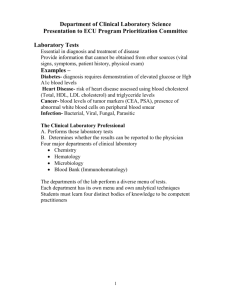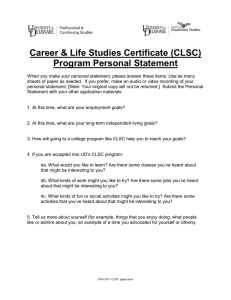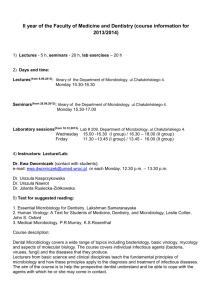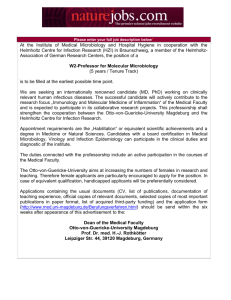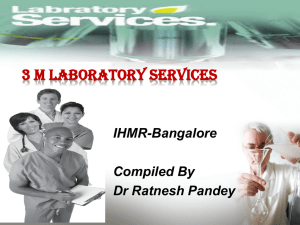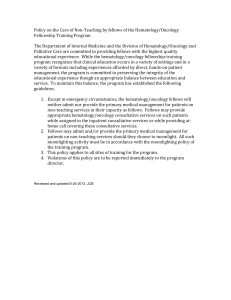BIOL 455 CLS - Winona State University
advertisement
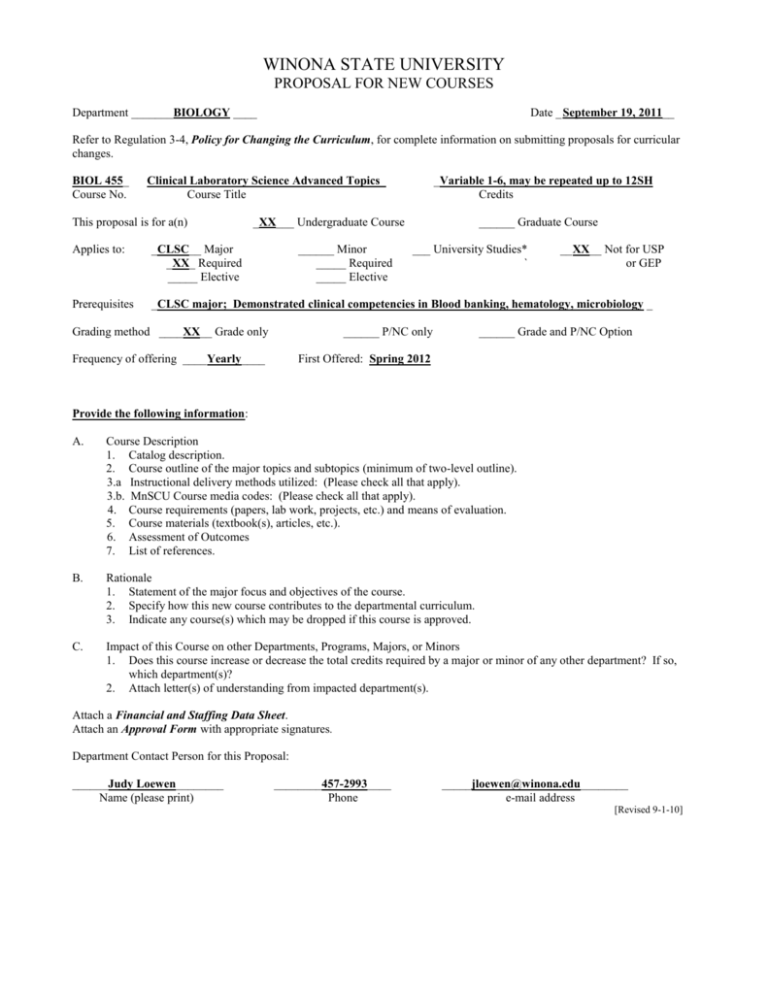
WINONA STATE UNIVERSITY PROPOSAL FOR NEW COURSES Department _______BIOLOGY ____ Date _September 19, 2011__ Refer to Regulation 3-4, Policy for Changing the Curriculum, for complete information on submitting proposals for curricular changes. BIOL 455_ Course No. Clinical Laboratory Science Advanced Topics_ Course Title This proposal is for a(n) _Variable 1-6, may be repeated up to 12SH Credits _XX___ Undergraduate Course ______ Minor _____ Required _____ Elective ______ Graduate Course Applies to: _CLSC__ Major _XX_ Required _____ Elective ___ University Studies* ` Prerequisites _CLSC major; Demonstrated clinical competencies in Blood banking, hematology, microbiology _ Grading method ____XX__ Grade only ______ P/NC only Frequency of offering ____Yearly____ First Offered: Spring 2012 __XX__ Not for USP or GEP ______ Grade and P/NC Option Provide the following information: A. Course Description 1. Catalog description. 2. Course outline of the major topics and subtopics (minimum of two-level outline). 3.a Instructional delivery methods utilized: (Please check all that apply). 3.b. MnSCU Course media codes: (Please check all that apply). 4. Course requirements (papers, lab work, projects, etc.) and means of evaluation. 5. Course materials (textbook(s), articles, etc.). 6. Assessment of Outcomes 7. List of references. B. Rationale 1. Statement of the major focus and objectives of the course. 2. Specify how this new course contributes to the departmental curriculum. 3. Indicate any course(s) which may be dropped if this course is approved. C. Impact of this Course on other Departments, Programs, Majors, or Minors 1. Does this course increase or decrease the total credits required by a major or minor of any other department? If so, which department(s)? 2. Attach letter(s) of understanding from impacted department(s). Attach a Financial and Staffing Data Sheet. Attach an Approval Form with appropriate signatures. Department Contact Person for this Proposal: ______Judy Loewen________ Name (please print) ________457-2993____ Phone _____jloewen@winona.edu________ e-mail address [Revised 9-1-10] A. Course Description 1. Catalog Description: 455- Clinical Laboratory Science Advanced Topics. Topics will include advanced hematology, advanced microbiology, advanced immunohematology, and the clinical internship management component for the Clinical Laboratory Science – Completion program. Prerequisites: Clinical Laboratory Science Completion (CLSC) major with successful clinical competency test completion and instructor’s permission. Letter grade only. Offered yearly, semester hours will be variable from 1-6 semester credits. May be repeated to a maximum of 12 SH. 2. Course Outline of Major Areas of Content: These are designed to be offered as special advanced courses with topics covering the newest clinical methods of procedures and techniques in the areas of clinical hematology, immunohematology, and microbiology. It will also include an individual management clinical internship project that will be unique for each student based upon her or his clinical experience and internship placement site. This course will only be open to CLSC major students who have successfully passed a comprehensive clinical competency testing evaluation. Clinical HematologyI. Orientation to Online Learning a. Welcome to online learning b. How Do I know what to do each week? c. How do I access course content? d. How so I ask questions? e. How do I post a discussions comment? f. How do I deposit a dropbox document g. How do I take a quiz? II. Comprehensive Assignment III. Introduction to hematology a. Routine hematology b. Hematopoietic Organs c. The Leukocytes and their Disorders 1. Leukocyte morphology and physiology 2. Nonmalignant Granulocyte and Monocyte Disorders 3. Nonmalignant Lymphocyte Disorders 4. Myeloproliferative Disorders 5. Myelodysplastic Syndromes 6. Acute Myelogenous Leukemia 7. Acute Lymphocytic Leukemia 8. Lymphoid Malignancies 9. Introduction to Hematopoietic Neoplasms d. Erythrocytes and their Disorders 1. Erythrocyte morphology and physiology 2. Hemoglobin 3. Hemoglobinopathies 4. Introduction to Anemia 5. Hemolytic Anemias 6. Anemias of Disordered Iron Metabolism 7. Thalassemia 8. Megaloblastic and Nonmegaloblastic macrocytic Anemias 9. Hypoproliferative Anemias 10. Bone Marrow IV. Mathematics for the Hematology Lab a. Douchette Text powerpoint b. Hematology Basic Math: Sample problems V. Lab techniques a. Instrumentation b. Pipetting Clinical Immunohematology I. Orientation to Online Learning a. Welcome to online learning b. How do I know what to do each week? c. How do I access course content? d. How do I ask questions? e. How do I post a discussions comment/ f. How so I deposit a dropbox document? g. How do I take a quiz? II. Comprehensive Assignment III. Introduction to Immunohematology a. Principles and Genetics b. Major Blood Groups c. Clinical Considerations in Immunohematology d. Quality and Safety Issues e. Antibody Detection and Identification f. Current Topics and Seminars IV. Lab Techniques a. Review, cell suspensions b. Cross matching, tube and gel methods c. Routine antibody detections-panels d. Advanced antibody techniques- Elutions e. Advanced problems- multiple antibody panels V. Links for reference, clinical experience a. American Association of Blood Banking b. American Society for Clinical Pathology c. American Society for Clinical Laboratory Science d. National Credentialing Agency for Laboratory Personnel, Inc e. Transfusion Medicine Education Clinical Microbiology I. Orientation to Online Learning a. Welcome to online learning b. How do I know what to do each week? c. How do I access course content? d. How do I ask questions? e. How do I post a discussions comment/ f. How so I deposit a dropbox document? g. How do I take a quiz? II. Comprehensive Assignment III. Introduction to Clinical Microbiology a. Bacteria b. Control of Microorganisms c. Bacterial Diseases of Humans d. Viruses e. The Fungi f. The Protozoa g. The Multicellular parasites IV. Simulation Lab techniques V. Case Studies VI. Resources and Links. a. ASM- American Society for Microbiology b. iTeach- Microbiology Protocols and images c. Indiana Pathology Images- Parasitology d. Indiana Pathology Images – Mycology e. Indiana Pathology Images – Bacteriology 3 a. Instructional delivery methods utilized: (Please check all that apply). None: Internet Independent Study Satellite ITV Sending Taped CD Rom Broadcast TV ITV Receiving b. MnSCU Course media codes: (Please check all that apply Lecture: ITV Online XX Auditorium Service Learning Travel Study Lecture: Classroom XX Other: (Please indicate) Web Enhanced XX Web Supplemented Web Enhanced XX Web Supplemented Laboratory XX Internship/Practicum 4. Course Requirements This course will include quizzes, exams, and laboratory exercises. Students must attend all sessions, both classroom and laboratory (typically 5 times/semester in blocks of 4 to 5 hours). Students must complete all laboratory exercises including (depending on the specific topic): Case presentations of peripheral blood smears, bone marrow smears, or microbial infections Identification of both normal and abnormal cells in peripheral blood and bone marrow smears Identification of both normal and abnormal microbial cultures Students must complete all online assignments and all homework assignments using the D2L drop box format which allows for instructor feedback and communication. Students must successfully pass all quizzes and exams. 5. Course Materials (depending on the specific topic): Clinical Laboratory Hematology – Mc Kenzie. 2nd ed., 2010; ISBN # 0-13-019996-6 Clinical Hematology Atlas, Carr, 3rd ed, 2008; ISBN # 978-1-4160-5039-1 Mathematics for the Clinical Laboratory, Doucette, 2nd ed, 2010; ISBN # 978-1-4377-0179-1 Linne and Ringrud’s Clinical Laboratory Science The Basics and Routine Techniques, Turgeon, 6th ed, 2010; ISBN # 978-0-323-06782-9 Modern Blood Banking and Transfusion Practices – Harmening , 5th ed, 2008; ISBN # 0-8036-1248-6 Microbiology A Systems Approach – Cowan , 3rd ed, 2011; ISBN # 0-07-352252-4 Principles of Clinical Laboratory Management, Hudson, 2008; ISBN # 0-13-049538-7 Aperio digital slide program inclusive with 300 digital slides for review and observation, and 22 different case presentations for mastery of skills. This includes peripheral blood and bone marrow matching samples per each case presentation with additional test review and cytogenetic components. New York Medical Blood banking case reviews. Guest speakers in areas of expertise. Dr. Lauren Anthony, Pathology Director for clinical labs, Allina Health Group, Abbott Northwestern Hospital. Dr. Rodney Higgins – Clinical Director for cytogenetics, Allina Health Group, Abbott Northwestern Hospital Dr. Steven Wiesner – Associate professor University of Minnesota Twin cities campus Danny Gebrekidan – Shift supervisor in Immunohematology at Children’s Hospital. 6. Outcomes and Assessment: Students will demonstrate problem solving skills in the areas of clinical hematology, immunohematology, and clinical microbiology Students will demonstrate an understanding of laboratory safety Students will demonstrate following skills in a clinical laboratory setting (depending on the specific topic): Cross match antibody screening Elutions and antibody titers Antibiotic MIC levels accurately read and titered Organism identification correct for a level 4 lab, Genus, species and serological level Interpretation of molecular probes for microbiology identification. 100 % accuracy. Implementation of management procedures Outcomes will be assessed by quizzes for normal reference levels and ranges; exams for knowledge and theory; Observation of problem solving and clinical skills. Ultimate assessment of these outcomes will be successful passing of their clinical certification examinations or board of registry examinations in these areas. 7. References: Established levels of practice- ASCP American Society of Clinical Pathologists, National governing body for clinical practices and standards. Students must pass a national board of registry to practice in a clinical laboratory. These standards are published on the website for ASCP. Text Book- ASCP Board of Registry Review, ASCP, ISBN # 0-891894160 NAACLS , National Accrediting Agency for Clinical Laboratory Science, Standards for Accreditation of education programs. www.NAACLS.org B. Rationale 1. Major focus and objectives of the course. This course will be a means to complete the advanced training in theory and techniques for current 2-year certified medical laboratory technicians( MLT) who are going to WSU as a completion program and degree to get their BS degree in Clinical laboratory science. The differences in levels of practice and education between the 2-year programs and the 4-year degree programs requires additional training and advanced education in theory specifically within these areas of emphasis- microbiology, hematology, immunohematology and management. The students are required to have passed their 2-year MLT certification examination. They are required to have current work experience within a working clinical laboratory. They are required to pass a clinical competency class in all areas of clinical work inorder to apply for this completion program towards a CLS degree at WSU. The main focus for thus course is to provide the advanced education and theory, to allow for current levels of practice to be presented , and for a demonstration of leadership skills within the working clinical laboratory and management component. 2. Specify how this new course contributes to the departmental curriculum This new course allows us to meet those levels of practice as stated by NAACLS for advanced theory education. It allows these specific students and this specific degree pathway to build upon their past educational courses, give them career credits for work experience based upon that competency testing and allows them to receive partial course credit. They still need to take this course for these areas of expertise to complete the overall curriculum objectives for the 4 year degree option at WSU. 3. Course(s) which may be dropped if this course is approved . in the Completion option of Clinical Laboratory Science. None. It is only open to a specific degree track student C. Impact of this course on other departments, programs, majors or minors. 1. Does this course increase or decrease the total credits required by a major or minor of any other department? No. It affects only the CLSC option in the Biology department 2. Attach letter(s) of understanding from impacted department(s). Not applicable WINONA STATE UNIVERSITY FINANCIAL AND STAFFING DATA SHEET Course __Biology 455: CLS Advanced Topics_ Include a Financial and Staffing Data Sheet with any proposal for a new course, new program, or revised program. Please answer the following questions completely. Provide supporting data. 1. Would this course or program be taught with existing staff or with new or additional staff? If this course would be taught by adjunct faculty, include a rationale. This course will be taught by current probationary and/or fixed-term faculty with support through OCED provided through tuition from students enrolled in the online CLS completion program. 2. What impact would approval of this course/program have on current course offerings? Please discuss number of sections of current offerings, dropping of courses, etc. These courses are part of the online CLS degree completion program and one section with a specific advanced topic will be taught each semester. CLS, and in particular the online completion option, is the most rapidly growing major within the Biology department and is now our third largest major (of seven), so to some degree this does represent a shift of faculty assignments to meet that increased student demand. We anticipate this shift in student demand will result in the rduction of one section per semester of a multiple-section course with lower enrollment such as Biology 104 or Biology 118. 3. What effect would approval of this course/program have on the department supplies? Include date to support expenditures for staffing, equipment, supplies, instructional resources. etc. There should be no increased need for department supplies that would not be reimbursed through course fees being developed by OCED.
